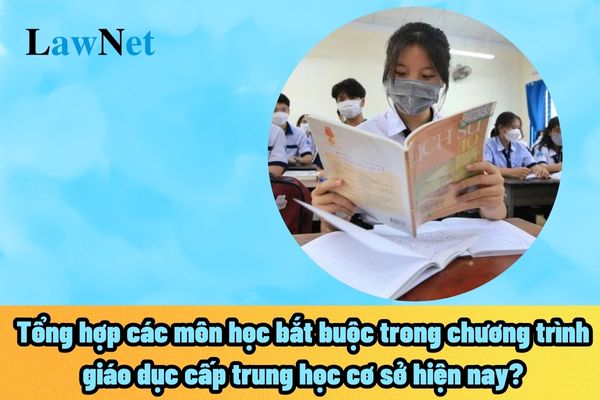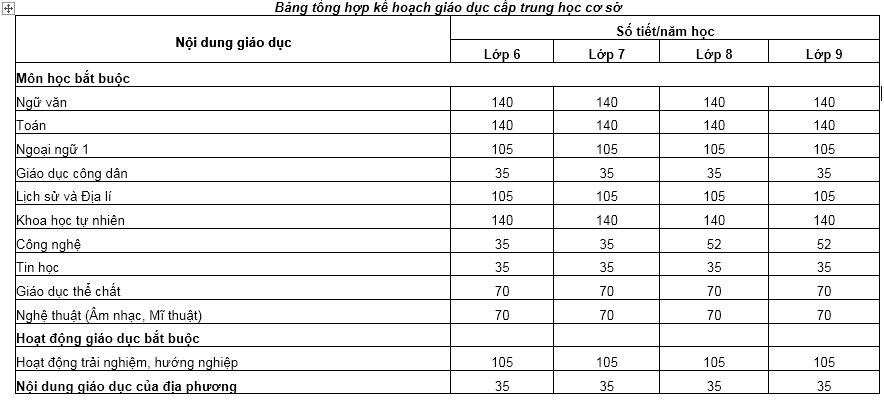Vietnam: Compilation of compulsory subjects in the current lower secondary education curriculum
Compilation of compulsory subjects in the current lower secondary education curriculum
According to Section 4 of the General Education Program issued together with Circular 32/2018/TT-BGDDT of the Ministry of Education and Training of Vietnam, amended and supplemented by Clause 1, Article 1 of Circular 13/2022/TT-BGDDT as follows:
Career orientation stage
...
Secondary Level
a) Educational Content
Compulsory subjects and educational activities: Vietnamese Literature; Mathematics; Foreign Language 1; Civic Education; History and Geography; Natural Sciences; Technology; Information Technology; Physical Education; Arts (Music, Fine Arts); Experiential and Vocational Activities; Local Education Content.
Elective subjects: Ethnic Minority Languages, Foreign Language 2.
...
Thus, according to the aforementioned regulations, the compulsory subjects and activities include:
Vietnamese Literature; Mathematics; Foreign Language 1; Civic Education; History and Geography; Natural Sciences; Technology; Information Technology; Physical Education; Arts (Music, Fine Arts); Experiential and Vocational Activities; Local Education Content.

Summary of compulsory subjects in the current secondary education program (Image from the Internet)
What are the durations prescribed for compulsory subjects in the secondary education program?
According to Section 4 of the General Education Program issued together with Circular 32/2018/TT-BGDDT, amended by Clause 1, Article 1 of Circular 13/2022/TT-BGDDT as follows:
Career Orientation Stage
...
1.2. Secondary Level
a) Educational Content
Compulsory subjects and educational activities: Vietnamese Literature; Mathematics; Foreign Language 1; Civic Education; History and Geography; Natural Sciences; Technology; Information Technology; Physical Education; Arts (Music, Fine Arts); Experiential and Vocational Activities; Local Education Content.
Elective subjects: Ethnic Minority Languages, Foreign Language 2.
b) Educational Duration
Each day includes 1 session, with no more than 5 periods per session; each period lasts 45 minutes. Schools that meet the conditions are encouraged to implement full-day schooling according to the guidelines of the Ministry of Education and Training.

Thus, according to the above regulations, the specific durations for compulsory subjects in the secondary education program are:
- Vietnamese Literature, Mathematics: 140 periods;
- Foreign Language 1: 105 periods;
- Civic Education: 35 periods;
- History and Geography: 105 periods;
- Natural Sciences: 140 periods;
- Technology: 35 periods (grades 6, 7); 52 periods (grades 8, 9);
- Information Technology: 35 periods;
- Physical Education: 70 periods;
- Arts (Music, Fine Arts): 70 periods;
- Experiential and Vocational Activities: 105 periods;
- Local Education Content: 35 periods
How is the implementation schedule for the secondary education program structured per stage?
According to Article 2 of Circular 32/2018/TT-BGDDT, the general education program, including the secondary education program, is implemented in the following stages:
- From the academic year 2020-2021 for grade 1.
- From the academic year 2021-2022 for grades 2 and 6.
- From the academic year 2022-2023 for grades 3, 7, and 10.
- From the academic year 2023-2024 for grades 4, 8, and 11.
- From the academic year 2024-2025 for grades 5, 9, and 12.
What are the orientations and evaluation criteria for the secondary education level?
According to Section 6 of the General Education Program issued together with Circular 32/2018/TT-BGDDT, amended by Clause 1, Article 1 of Circular 13/2022/TT-BGDDT:
- The objective of education evaluation is to provide accurate, timely, and valuable information about the level of meeting the program's requirements and the students' progress to guide learning activities, adjust teaching activities, manage and develop the curriculum, ensure the progress of each student, and enhance the quality of education.
- The evaluation basis includes the required achievements in terms of qualities and capabilities defined in the general program and subject programs.
- The evaluation scope includes compulsory subjects and educational activities, elective subjects, and specialized study topics. The evaluation subjects are the products and learning processes of students.
- Educational outcomes are evaluated through qualitative and quantitative formats including regular, periodic evaluations at educational institutions, large-scale national and local evaluations, and international assessments.
- Along with the results of compulsory subjects and educational activities, the results of elective subjects and specialized study topics are used for overall evaluation of students' learning outcomes throughout the academic year and the entire learning process.
- Regular evaluations are organized by subject teachers and combine teacher evaluations, parent evaluations, self-assessments by students, and peer evaluations.
- Periodic evaluations are organized by educational institutions to manage teaching activities and maintain educational quality within the institution and support curriculum development.
- Large-scale national and local evaluations are organized by national or provincial testing organizations to manage teaching activities, maintain educational quality at educational institutions, support curriculum development, and enhance education quality.
- Evaluation methods ensure reliability, objectivity, suitability for each age group and educational level, do not place undue pressure on students, and minimize costs for the state budget, students' families, and society.
- Efforts are made to gradually apply scientific achievements in educational measurement and evaluation and international experiences to improve the evaluation quality of educational outcomes and student classification at educational institutions and to use large-scale evaluation results as tools for controlling evaluation quality at educational institutions.
>> View the Appendix issued together with Circular 32/2018/TT-BGDDT: Download (Note: Some content in this file is amended by Article 1, Article 2 of Circular 13/2022/TT-BGDDT)

